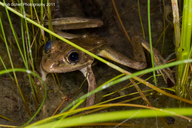|
Description
R. onca has a snout-vent length between 44 and 87 mm, and is distinquished from similar species of the Rana pipiens complex by its short, indistinct, dorsolateral folds that extend 1/2 to 3/4 down the dorsum, generally shortened legs, an incomplete supralabial stripe, upper surfaces of the thighs usually spotted and not barred, and males having enlarged tympana, paired vocal sacs, and no vestigial oviducts. It has a dorsum which is brown, gray, or greenish above, with discrete greenish-brown spots that are usually reduced or faded on the front of the body. These dorsal spots are indefinitely bordered and are usually present on the upper surfaces of the thighs. Usually, the venter is whitish, and the throat has dark mottling. The groin and the undersides of the hind limbs are yellow to yellow-orange.
Distribution and Habitat
Country distribution from AmphibiaWeb's database: United States U.S. state distribution from AmphibiaWeb's database: Arizona, Nevada, Utah
R. onca was found in creeks, springs, and seeps in the vicinity of Las Vegas Valley, Clark County, Nevada, and the Virgin River Valley, Washington County, Utah, at elevations between 370 and 760 m. Many of these populations are now extinct. Recent field work has discovered a few small populations in extreme northwestern Arizona along the Virgin River, from near Littlefield downstream to the Overton Arm of artificial Lake Mead. New populations have been discovered in springs that enter the Colorado River in Black Canyon, south of Hoover Dam in California.
Life History, Abundance, Activity, and Special Behaviors
The fully developed tadpoles reach 85 mm in length and have a greenish olive dorsum, a heavily mottled, pale green-yellow tail, and a light venter. Labial teeth are 2/3 or 1/3 with the second upper row short or absent.
Trends and Threats
R. onca once occurred at the edge of the ranges of R. chiricahuensis, R. pipiens, and R. yavapaiensis, and survived as a relict population in the marginal habitat of desert springs and creeks. However, since 1920 there have been severe habitat alterations as well as introductions of non-native fish and amphibians into these habitats, which pushed R. onca populations into decline. The last known specimens from Utah were collected in 1950 from Berry Springs, Washington County. Extant populations are small and highly vulnerable.
Relation to Humans
The species was once common in the springs of Las Vegas, Nevada, where it was described as a distinct species (R. fisheri). Springs have been developed for human use, including domestic water, animal husbandry, and recreation (hot springs). Many springs were inundated by the construction of Hoover Dam and the rising of Lake Mead.
Possible reasons for amphibian decline General habitat alteration and loss
Predators (natural or introduced)
Introduced competitors
Comments
This is a minor success story. The species was long thought to be extinct or near extinction. Although extant populations have been found, they exist in isolated springs and creeks in desert environments, near reservoirs and recreation sites in an area that has rapidly urbanized. Accordingly, the species must be considered to be highly vulnerable. Jaeger et al. (2001) recommend development of a conservation management plan for the few remnant populations; such a conservation plan must prioritize the identification of habitat requirements and the reclamation of habitats necessary to maintain population viability.
References
Jaeger, J. R., Riddle, B. R., Jennings, R. D., and Bradford, D. F. (2001). ''Rediscovering Rana onca: evidence for phylogenetically distinct leopard frogs from the border region of Nevada, Utah, and Arizona.'' Copeia, 2001(2), 339-354.
Jennings, M. R. (1988). ''Rana onca Cope, relict leopard frog.'' Catalogue of American Amphibians and Reptiles. American Society of Ichthyologists and Herpetologists, 417.1-417.2.
Originally submitted by: Franziska Sandmeier (first posted 2001-02-21)
Edited by: Arie van der Meijden (28/2/2001) (2009-08-24)Species Account Citation: AmphibiaWeb 2009 Rana onca: Relict Leopard Frog <https://amphibiaweb.org/species/5118> University of California, Berkeley, CA, USA. Accessed Apr 18, 2024.
Feedback or comments about this page.
Citation: AmphibiaWeb. 2024. <https://amphibiaweb.org> University of California, Berkeley, CA, USA. Accessed 18 Apr 2024.
AmphibiaWeb's policy on data use.
|






 Map of Life
Map of Life